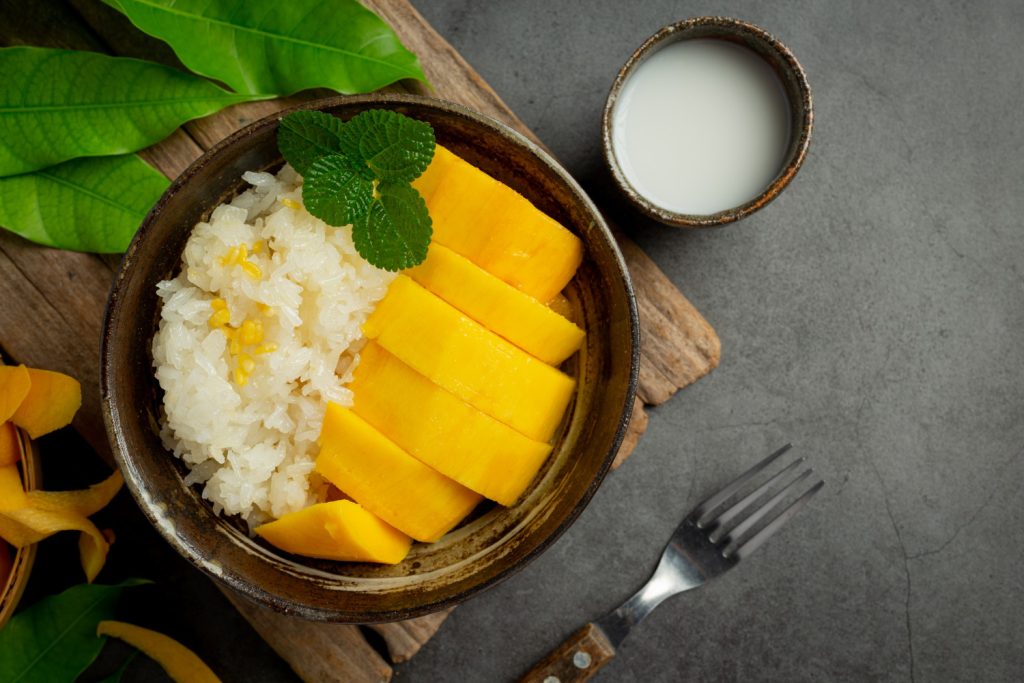Mango Sticky Rice is a beloved Thai dessert enjoyed by many during the warm seasons. This delightful dish brings together the sweetness of ripe mangoes and the rich, creamy flavour of sticky rice. It’s a simple yet captivating treat that showcases the essence of Thai cuisine.
The origins of Mango Sticky Rice are deeply rooted in Thai culture, often linked with special occasions and festivals. This dessert is traditionally made using glutinous rice, coconut milk, and fresh mangoes. The combination creates a harmony of flavours and textures that’s hard to resist.
At Nar Bangkok Modern Thai, we take pride in serving this exquisite dessert, made with the finest ingredients sourced locally. Mango Sticky Rice is not only a treat for the taste buds but also offers numerous health benefits, thanks to its fresh components. This summer, we invite you to indulge in the timeless joy of Mango Sticky Rice and experience a true Thai classic.
The Origins and Cultural Significance of Mango Sticky Rice
Mango Sticky Rice has a long history in Thailand, dating back hundreds of years. It originated in Southeast Asia, where sticky rice is a staple food. This dessert is often associated with the mango season, which typically runs from April to June. During this time, Thai people celebrate various festivals and ceremonies, and Mango Sticky Rice is a popular treat.
The dish holds cultural significance as it is commonly enjoyed during Songkran, the Thai New Year. Songkran is celebrated in mid-April, marking the end of the dry season and the beginning of the rainy season. Families come together to make this dessert, symbolising unity and prosperity. The use of sticky rice, a cultural staple, reflects the importance of rice in Thai society.
Mango Sticky Rice also plays a role in Buddhist traditions. It is often offered to monks as a part of almsgiving ceremonies. The simplicity and elegance of this dessert make it a revered offering. Through generations, Mango Sticky Rice has continued to be a beloved dish, uniting families and communities in celebration and tradition.
Key Ingredients That Make Mango Sticky Rice Special
The magic of Mango Sticky Rice lies in its simple yet flavourful ingredients. Each component plays a crucial role in creating the perfect balance of sweetness and creaminess. Here are the key ingredients that make this dessert special:
1. Glutinous Rice: Glutinous rice, also known as sticky rice, is the base of the dish. It has a unique, sticky texture, perfect for absorbing the flavours of coconut milk. When cooked properly, it becomes soft and chewy, creating the perfect foundation for the dessert.
2. Coconut Milk: Coconut milk adds a rich, creamy flavour that complements the sweetness of the mangoes. It’s mixed with sugar and a pinch of salt to enhance the taste and provide a smooth coating for the sticky rice.
3. Ripe Mangoes: Fresh, ripe mangoes are essential for this dessert. They should be sweet and juicy, adding a natural sweetness that balances the creaminess of the rice. The fragrant, succulent mango slices elevate the dish to a new level of delight.
4. Sugar and Salt: These simple seasonings are mixed with coconut milk to give just the right amount of sweetness and a hint of saltiness. This combination enhances the overall flavour profile of the dish.
5. Toasted Mung Beans (optional): Some recipes include toasted mung beans sprinkled over the top for an added crunch. This optional ingredient provides a delightful contrast in texture and adds a bit of nuttiness to the dessert.
Using high-quality ingredients is crucial in making Mango Sticky Rice. Each element must be fresh and perfectly prepared to achieve the authentic taste that makes this dessert a favourite among many.
Step-by-Step Guide to Preparing Mango Sticky Rice at Home
Making Mango Sticky Rice at home can be a fun and rewarding experience. Follow these simple steps to create this delicious dessert.
1. Prepare the Sticky Rice:
– Rinse 1 cup of glutinous rice under cold water until the water runs clear.
– Soak the rice in water for at least 4 hours or overnight for the best texture.
– Drain the soaked rice and steam it in a basket or cheesecloth-lined steamer for about 25-30 minutes until cooked through and tender.
2. Make the Coconut Sauce:
– In a saucepan, combine 1 cup of coconut milk with 1/2 cup of sugar and 1/2 teaspoon of salt.
– Cook over medium heat, stirring constantly, until the sugar dissolves completely. Do not let it boil.
– Remove from heat and set aside a small amount of this mixture for later.
3. Mix the Rice and Coconut Sauce:
– While the sticky rice is still hot, transfer it to a bowl.
– Gradually pour the larger portion of the warm coconut sauce over the rice, stirring gently to combine.
– Cover the bowl and let it sit for 20-30 minutes to allow the rice to absorb the coconut flavour.
4. Prepare the Mangoes:
– Peel and slice 2 ripe mangoes into thin, even pieces.
5. Serve:
– Place a portion of the sticky rice on a plate.
– Arrange the mango slices beside the rice.
– Drizzle the reserved coconut sauce over the rice.
– Optionally, sprinkle toasted mung beans on top for added texture.
Enjoy your homemade Mango Sticky Rice, a delightful treat that brings a taste of Thailand to your table.
Health Benefits of Mango Sticky Rice and Choosing Fresh Ingredients
Mango Sticky Rice is not only tasty but also comes with several health benefits, especially when made with fresh ingredients. Here are some reasons why this dessert can be a healthy choice:
1. Nutrient-Rich Mangoes: Mangoes are a great source of vitamins A and C, which are essential for a healthy immune system and good vision. They also provide dietary fibre, aiding digestion and keeping you full longer.
2. Healthy Fats from Coconut Milk: Coconut milk contains medium-chain triglycerides (MCTs), a type of fat that can be used quickly by the body for energy. MCTs are known for their potential weight management benefits.
3. Gluten-Free Option: Glutinous rice is naturally gluten-free, making Mango Sticky Rice a suitable option for those with gluten sensitivities or celiac disease.
4. Natural Sweeteners: Using good quality, fresh ingredients means you can avoid artificial sweeteners and preservatives. Fresh mangoes and a moderate amount of sugar from the coconut sauce offer a natural sweetness.
Choosing fresh, locally sourced ingredients enhances the nutritional value of the dessert. Fresh mangoes from trusted sources and organic coconut milk contribute to a healthier dessert that you can enjoy guilt-free. By making Mango Sticky Rice with care, you can indulge in a delicious treat that also supports overall well-being.
Conclusion
Mango Sticky Rice is more than just a dessert; it’s a cultural treasure that brings the authentic flavours of Thailand to your plate. Its rich history, coupled with its simple yet effective ingredients, makes it a favourite for many. Whether celebrating a special occasion or simply enjoying a summer treat, Mango Sticky Rice never fails to impress with its delicious blend of sweet, creamy, and fruity flavours.
By following the steps to prepare it at home, you can enjoy this classic Thai dessert any time you like. Moreover, using fresh, locally sourced ingredients ensures a healthier and more nutritious version that supports local farmers and contributes to a sustainable community.
This summer, treat yourself to the delightful experience of Mango Sticky Rice at Nar Bangkok Modern Thai. Explore the authentic taste and cultural richness of Thailand in every bite. Visit Nar Bangkok Modern Thai in St. Kilda, Melbourne, and indulge in our best Thai food dishes, including our main dessert for the season. Experience the best of Thai cuisine with us today!

